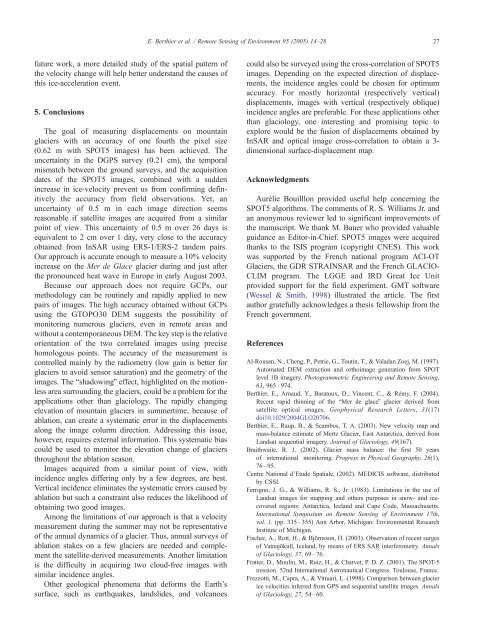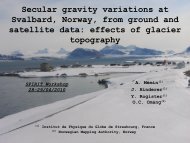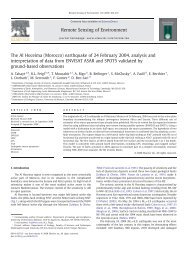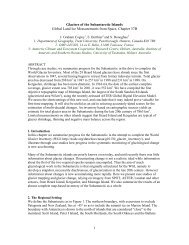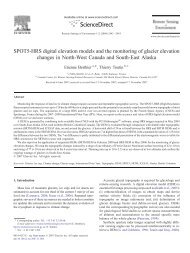Surface motion of mountain glaciers derived from satellite optical ...
Surface motion of mountain glaciers derived from satellite optical ...
Surface motion of mountain glaciers derived from satellite optical ...
Create successful ePaper yourself
Turn your PDF publications into a flip-book with our unique Google optimized e-Paper software.
E. Berthier et al. / Remote Sensing <strong>of</strong> Environment 95 (2005) 14–28 27future work, a more detailed study <strong>of</strong> the spatial pattern <strong>of</strong>the velocity change will help better understand the causes <strong>of</strong>this ice-acceleration event.5. ConclusionsThe goal <strong>of</strong> measuring displacements on <strong>mountain</strong><strong>glaciers</strong> with an accuracy <strong>of</strong> one fourth the pixel size(0.62 m with SPOT5 images) has been achieved. Theuncertainty in the DGPS survey (0.21 cm), the temporalmismatch between the ground surveys, and the acquisitiondates <strong>of</strong> the SPOT5 images, combined with a suddenincrease in ice-velocity prevent us <strong>from</strong> confirming definitivelythe accuracy <strong>from</strong> field observations. Yet, anuncertainty <strong>of</strong> 0.5 m in each image direction seemsreasonable if <strong>satellite</strong> images are acquired <strong>from</strong> a similarpoint <strong>of</strong> view. This uncertainty <strong>of</strong> 0.5 m over 26 days isequivalent to 2 cm over 1 day, very close to the accuracyobtained <strong>from</strong> InSAR using ERS-1/ERS-2 tandem pairs.Our approach is accurate enough to measure a 10% velocityincrease on the Mer de Glace glacier during and just afterthe pronounced heat wave in Europe in early August 2003.Because our approach does not require GCPs, ourmethodology can be routinely and rapidly applied to newpairs <strong>of</strong> images. The high accuracy obtained without GCPsusing the GTOPO30 DEM suggests the possibility <strong>of</strong>monitoring numerous <strong>glaciers</strong>, even in remote areas andwithout a contemporaneous DEM. The key step is the relativeorientation <strong>of</strong> the two correlated images using precisehomologous points. The accuracy <strong>of</strong> the measurement iscontrolled mainly by the radiometry (low gain is better for<strong>glaciers</strong> to avoid sensor saturation) and the geometry <strong>of</strong> theimages. The bshadowingQ effect, highlighted on the <strong>motion</strong>lessarea surrounding the <strong>glaciers</strong>, could be a problem for theapplications other than glaciology. The rapidly changingelevation <strong>of</strong> <strong>mountain</strong> <strong>glaciers</strong> in summertime, because <strong>of</strong>ablation, can create a systematic error in the displacementsalong the image column direction. Addressing this issue,however, requires external information. This systematic biascould be used to monitor the elevation change <strong>of</strong> <strong>glaciers</strong>throughout the ablation season.Images acquired <strong>from</strong> a similar point <strong>of</strong> view, withincidence angles differing only by a few degrees, are best.Vertical incidence eliminates the systematic errors caused byablation but such a constraint also reduces the likelihood <strong>of</strong>obtaining two good images.Among the limitations <strong>of</strong> our approach is that a velocitymeasurement during the summer may not be representative<strong>of</strong> the annual dynamics <strong>of</strong> a glacier. Thus, annual surveys <strong>of</strong>ablation stakes on a few <strong>glaciers</strong> are needed and complementthe <strong>satellite</strong>-<strong>derived</strong> measurements. Another limitationis the difficulty in acquiring two cloud-free images withsimilar incidence angles.Other geological phenomena that deforms the Earth’ssurface, such as earthquakes, landslides, and volcanoescould also be surveyed using the cross-correlation <strong>of</strong> SPOT5images. Depending on the expected direction <strong>of</strong> displacements,the incidence angles could be chosen for optimumaccuracy. For mostly horizontal (respectively vertical)displacements, images with vertical (respectively oblique)incidence angles are preferable. For these applications otherthan glaciology, one interesting and promising topic toexplore would be the fusion <strong>of</strong> displacements obtained byInSAR and <strong>optical</strong> image cross-correlation to obtain a 3-dimensional surface-displacement map.AcknowledgmentsAurélie Bouilllon provided useful help concerning theSPOT5 algorithms. The comments <strong>of</strong> R. S. Williams Jr. andan anonymous reviewer led to significant improvements <strong>of</strong>the manuscript. We thank M. Bauer who provided valuableguidance as Editor-in-Chief. SPOT5 images were acquiredthanks to the ISIS program (copyright CNES). This workwas supported by the French national program ACI-OTGlaciers, the GDR STRAINSAR and the French GLACIO-CLIM program. The LGGE and IRD Great Ice Unitprovided support for the field experiment. GMT s<strong>of</strong>tware(Wessel & Smith, 1998) illustrated the article. The firstauthor gratefully acknowledges a thesis fellowship <strong>from</strong> theFrench government.ReferencesAl-Rousan, N., Cheng, P., Petrie, G., Toutin, T., & Valadan Zoej, M. (1997).Automated DEM extraction and orthoimage generation <strong>from</strong> SPOTlevel 1B imagery. Photogrammetric Engineering and Remote Sensing,63, 965–974.Berthier, E., Arnaud, Y., Baratoux, D., Vincent, C., & Rémy, F. (2004).Recent rapid thinning <strong>of</strong> the bMer de glaceQ glacier <strong>derived</strong> <strong>from</strong><strong>satellite</strong> <strong>optical</strong> images. Geophysical Research Letters, 31(17)doi10.1029/2004GLO20706.Berthier, E., Raup, B., & Scambos, T. A. (2003). New velocity map andmass-balance estimate <strong>of</strong> Mertz Glacier, East Antarctica, <strong>derived</strong> <strong>from</strong>Landsat sequential imagery. Journal <strong>of</strong> Glaciology, 49(167).Braithwaite, R. J. (2002). Glacier mass balance: the first 50 years<strong>of</strong> international monitoring. Progress in Physical Geography, 26(1),76–95.Centre National d’Etude Spatiale, (2002). MEDICIS s<strong>of</strong>tware, distributedby CSSI.Ferrigno, J. G., & Williams, R. S., Jr. (1983). Limitations in the use <strong>of</strong>Landsat images for mapping and others purposes in snow- and icecoveredregions: Antarctica, Iceland and Cape Code, Massachusetts.International Symposium on Remote Sensing <strong>of</strong> Environment 17th,vol. 1. (pp. 335–355) Ann Arbor, Michigan7 Environmental ResearchInstitute <strong>of</strong> Michigan.Fischer, A., Rott, H., & Bjfrnsson, H. (2003). Observation <strong>of</strong> recent surges<strong>of</strong> Vatnajfkull, Iceland, by means <strong>of</strong> ERS SAR interferometry. Annals<strong>of</strong> Glaciology, 37, 69–76.Fratter, D., Moulin, M., Ruiz, H., & Charvet, P. D. Z. (2001). The SPOT-5mission. 52nd International Astronautical Congress. Toulouse, France.Frezzotti, M., Capra, A., & Vittuari, L. (1998). Comparison between glacierice velocities inferred <strong>from</strong> GPS and sequential <strong>satellite</strong> images. Annals<strong>of</strong> Glaciology, 27, 54–60.


